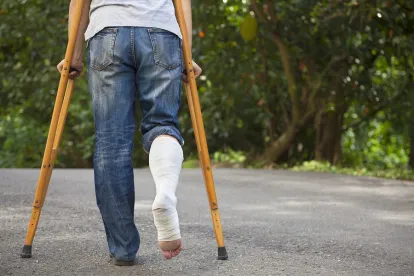In Noonan v. Illinois Workers’ Compensation Comm’n, 2016 IL App (1st) 152300WC, the Appellate Court, Workers’ Compensation Commission Division, recently affirmed the Commission’s denial of benefits to an employee who was injured while reaching for a pen at work. The court’s ruling provides guidance to employers when dealing with injuries arising from common or everyday activities, such as bending, stooping, or walking.
In Noonan, the claimant, Terry Noonan, alleged he sustained a work-related injury to his right wrist while working for the City of Chicago as a clerk. At arbitration, the claimant testified that his job duties included filling out forms called “truck driver sheets” and answering the phone when no one else was available.
The claimant testified that, on the date of accident, he was sitting in his desk chair, filling out truck driver sheets, when he accidentally knocked his pen off the desk with his elbow. The pen fell on the ground to the right of the claimant’s chair. He testified that he put his left hand on the desk for support and reached down to his right side to pick up the pen. When he was approximately two inches from picking up the pen, the chair slipped out from under him and he stuck his right hand out to brace his fall. The claimant testified he struck his right hand on the floor and felt like he “jammed” his wrist. He sought medical treatment and eventually underwent surgery to his right wrist.
The arbitrator found that the claimant failed to prove his right wrist injury “arose out of” his employment and denied benefits. According to the arbitrator, the claimant “failed to prove that the simple act of sitting in a rolling chair and reaching for a pen exposed him to an increased risk of injury that was beyond what general members of the general public are regularly exposed to.” Noonan, IL App (1st) 152300WC, ¶ 7. The claimant appealed and the Commission ultimately affirmed.
In order for a claimant to show his injury “arose out of” his employment, he must show: (1) the risk of injury is a risk peculiar to the work; or (2) is a risk to which the employee is exposed to a greater degree than the general public. In this case, the claimant asserted his wrist injury arose out of his employment because the act of attempting to retrieve a pen that he was using to fill out forms was in furtherance of his duties and, thus, was incidental to his employment.
Disagreeing with the claimant, the appellate court held that reaching for a dropped item while sitting in a chair was not an act the claimant was instructed to perform or had a duty to perform. The court also found that this act was not incidental to the claimant’s assigned job duties. In so doing, the court distinguished the claimant’s act at hand from those in Young v. Illinois Workers’ Compensation Comm’n, 2014 IL App (4th) 130392WC (injury from reaching and stretching into a narrow box were employment-related risks because these acts were necessary for fulfillment of part inspector’s job duties), and Autumn Accolade v. Illinois Workers’ Compensation Comm’n, 2013 IL App (3d) 120588WC (injury from reaching for a soap dish while assisting a patient was an employment-related risk because this act was in furtherance of caregiver’s job duties to ensure patient safety at assisted living facility), by determining the act of sitting in a chair and reaching to the ground was not one the employer might reasonably have expected the claimant to perform incident to his clerk duties.
Here, claimant’s job duties as a clerk required him to fill out forms and occasionally answer telephone calls. He was injured at work when the rolling chair he was sitting in “went out from underneath” him as he reached to retrieve a dropped pen. Although claimant was at work, the act he was performing when injured – reaching for a dropped item while sitting in a chair – was not one he was instructed to perform or had a duty to perform. Contrary to claimant’s assertions, we also find the act described was not incidental to his assigned duties. In particular, the act of reaching to the floor while sitting in a chair was not required by claimant’s job duties. Noonan, 2016 IL App (1st) 152300WC, ¶ 21
The court determined the act of sitting in a chair and reaching to the ground to retrieve a pen is an act that presents a neutral risk. Injury from this act is only compensable if claimant showed he was exposed to the risk to a greater degree than the general public. Employment related risks associated with injuries from a fall are those which the general public is not exposed, or performing some work-related task which contributes to the risk of falling.
Here, the court found there was no evidence of a defective condition on the employer’s premises which contributed to the fall and that there was no evidence that any work-related task contributed to the claimant’s fall.
Finally, the claimant argued that he was exposed to a risk that was greater than the general public because he had suffered a previous work-related back injury which prevented him from bending forward and required him to bend sideways to pick up the dropped pen. The court again disagreed with the claimant, finding that this injury did not involve a “progression” of a work-related injury to the same body part. The court noted that the claimant had previously injured his back and that this claim related to a right wrist injury. The claimant could not show that bending to the right increased his risk of falling over while reaching in the chair. The act of turning or bending in a chair to reach to the ground, without more, was found insufficient to establish a work-related cause to his accidental injury.
Possible Impact
Interestingly, the court’s majority opinion did not address its recent decision in Adcock v. Illinois Workers’ Compensation Comm’n, 2015 IL App (2d) 130884WC. In Adcock, the majority held that benefits should not be awarded for injuries caused by everyday activities like walking, bending, or turning, even if those activities were part of the employee’s job duties, unless the employee’s job required him to perform those activities more frequently than members of the general public or in a manner that increased the risk. The Adcock opinion itself was a departure from the prior analysis utilized in Young and Autumn Accolade, which had suggested that a neutral risk analysis is unnecessary where the employee is injured while performing his or her required work duties.
In the Noonan case, prior to a neutral risk analysis, the court first engaged in an analysis of whether claimant’s act of sitting in a chair and reaching to the ground for a pen was an employment-related risk. Only upon determining that this was not an employment-related risk, did the court proceed with a neutral risk analysis.
The special concurrence, authored by Justice Holdridge, concluded that injuries which stemmed from everyday activities, like the instant case, must be analyzed pursuant to neutral risk principles pursuant to Adcock, even if the risk is incidental to the claimant’s job duties. The special concurrence concluded Young and Autumn Accolade were wrongly decided and further stated that he would decline to follow them.
In addition, the dissenting opinion, authored by Justice Stewart, argued that an employer should reasonably expect a clerical employee to bend over and pick up a dropped pen, thus, making claimant’s injury the result of an employment-related risk. “[A]ny employer should reasonably expect a clerical employee to ned over and pick up a dropped pen.” Noonan, 2016 IL App (1st) 152300WC, ¶ 44. According to the dissent, “if a worker is injured performing an everyday activity, such as ‘bending over,’ and that activity is incidental to his employment, the injury results from an employment risk, and neutral-risk analysis should not be employed.” Id., ¶ 45. Although disagreeing with the result, the dissent agreed with the majority’s approach that an injury stemming from an everyday activity must be analyzed for an employment-related risk first, and then, only if the risk is not employment related, moving to the neutral risk analysis as established in Young.
The Noonan decision suggests that a majority of the court will continue to use this tripart risk analysis in determining if an injury “arose out of” the employment, even if the injury resulted from an everyday activity like walking, bending, or turning.




 />i
/>i


